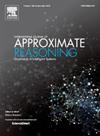解释由知识图谱嵌入生成的答案
IF 3.2
3区 计算机科学
Q2 COMPUTER SCIENCE, ARTIFICIAL INTELLIGENCE
引用次数: 0
摘要
大型知识库(如 DBPedia 或 Freebase)的完成通常依赖于将符号关系转化为基于向量的表示的嵌入模型。这种嵌入模型对人类用户来说相当不透明。可解释性研究强调的是深度神经网络等非关系分类器,而对知识图嵌入等从关系结构中提取的不透明模型的研究则较少。我们介绍的技术可以为基于知识图嵌入的预测提供解释,并以逻辑规则的形式表达。算法根据输入知识图谱中的路径建立解释,并通过上下文和启发式线索进行搜索。本文章由计算机程序翻译,如有差异,请以英文原文为准。
Explaining answers generated by knowledge graph embeddings
Completion of large-scale knowledge bases, such as DBPedia or Freebase, often relies on embedding models that turn symbolic relations into vector-based representations. Such embedding models are rather opaque to the human user. Research in interpretability has emphasized non-relational classifiers, such as deep neural networks, and has devoted less effort to opaque models extracted from relational structures, such as knowledge graph embeddings. We introduce techniques that produce explanations, expressed as logical rules, for predictions based on the embeddings of knowledge graphs. Algorithms build explanations out of paths in an input knowledge graph, searched through contextual and heuristic cues.
求助全文
通过发布文献求助,成功后即可免费获取论文全文。
去求助
来源期刊

International Journal of Approximate Reasoning
工程技术-计算机:人工智能
CiteScore
6.90
自引率
12.80%
发文量
170
审稿时长
67 days
期刊介绍:
The International Journal of Approximate Reasoning is intended to serve as a forum for the treatment of imprecision and uncertainty in Artificial and Computational Intelligence, covering both the foundations of uncertainty theories, and the design of intelligent systems for scientific and engineering applications. It publishes high-quality research papers describing theoretical developments or innovative applications, as well as review articles on topics of general interest.
Relevant topics include, but are not limited to, probabilistic reasoning and Bayesian networks, imprecise probabilities, random sets, belief functions (Dempster-Shafer theory), possibility theory, fuzzy sets, rough sets, decision theory, non-additive measures and integrals, qualitative reasoning about uncertainty, comparative probability orderings, game-theoretic probability, default reasoning, nonstandard logics, argumentation systems, inconsistency tolerant reasoning, elicitation techniques, philosophical foundations and psychological models of uncertain reasoning.
Domains of application for uncertain reasoning systems include risk analysis and assessment, information retrieval and database design, information fusion, machine learning, data and web mining, computer vision, image and signal processing, intelligent data analysis, statistics, multi-agent systems, etc.
 求助内容:
求助内容: 应助结果提醒方式:
应助结果提醒方式:


